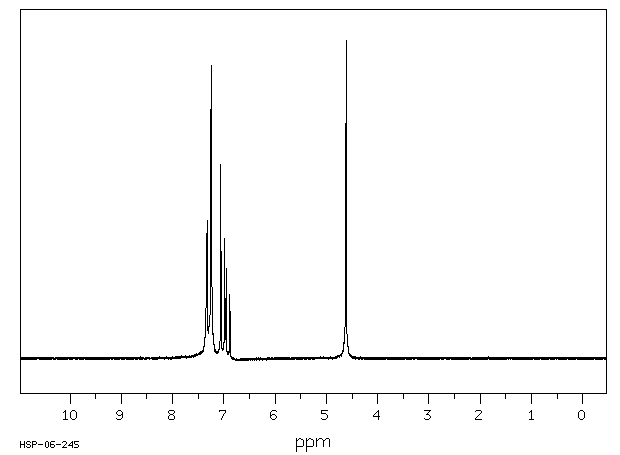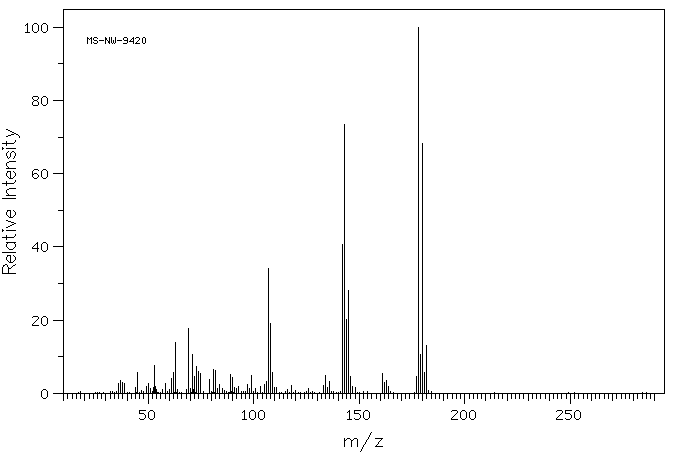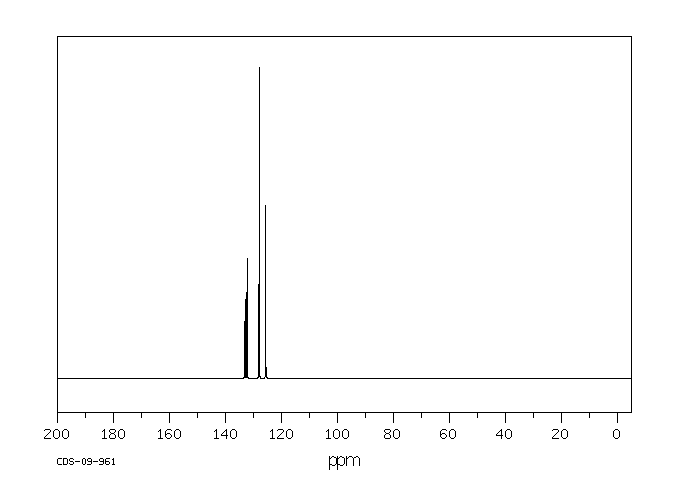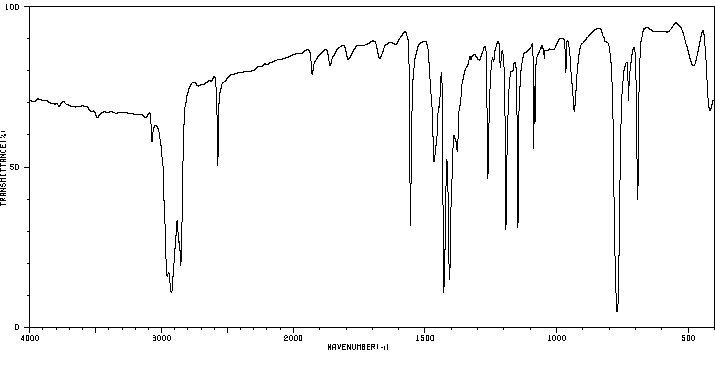2,6-二氯苯硫酚 | 24966-39-0
中文名称
2,6-二氯苯硫酚
中文别名
2,6-二氯硫酚
英文名称
2,6-dichlorothiophenol
英文别名
2,6-dichlorobenzenethiol;2,6-dichlorobenzene-1-thiol
CAS
24966-39-0
化学式
C6H4Cl2S
mdl
MFCD00004833
分子量
179.07
InChiKey
JBISHCXLCGVPGW-UHFFFAOYSA-N
BEILSTEIN
——
EINECS
——
-
物化性质
-
计算性质
-
ADMET
-
安全信息
-
SDS
-
制备方法与用途
-
上下游信息
-
文献信息
-
表征谱图
-
同类化合物
-
相关功能分类
-
相关结构分类
物化性质
-
熔点:48-50 °C(lit.)
-
沸点:119-120 °C (10 mmHg)
-
密度:1.3905 (estimate)
-
闪点:>230 °F
-
稳定性/保质期:
遵照规定使用和储存则不会分解,没有已知的危险反应。避免与氧化剂接触。
计算性质
-
辛醇/水分配系数(LogP):3.3
-
重原子数:9
-
可旋转键数:0
-
环数:1.0
-
sp3杂化的碳原子比例:0.0
-
拓扑面积:1
-
氢给体数:1
-
氢受体数:1
安全信息
-
危险品标志:Xi
-
安全说明:S26,S37/39
-
危险类别码:R36/37/38
-
WGK Germany:3
-
海关编码:2930909090
-
危险品运输编号:UN 2811 6.1/PG 3
-
包装等级:III
-
危险类别:6.1
-
危险性防范说明:P501,P261,P270,P271,P264,P280,P337+P313,P305+P351+P338,P361+P364,P332+P313,P301+P310+P330,P302+P352+P312,P304+P340+P311,P403+P233,P405
-
危险性描述:H301+H311+H331,H315,H319
-
储存条件:请将药品存放在密闭、阴凉、通风干燥的地方。
SDS
| Name: | 2 6-Dichlorobenzenethiol 97% Material Safety Data Sheet |
| Synonym: | |
| CAS: | 24966-39-0 |
Synonym:
Section 2 - COMPOSITION, INFORMATION ON INGREDIENTS
| CAS# | Chemical Name | content | EINECS# |
| 24966-39-0 | 2,6-dichlorobenzenethiol, 97% | 97 | unlisted |
Risk Phrases: 36/37/38
Section 3 - HAZARDS IDENTIFICATION
EMERGENCY OVERVIEW
Irritating to eyes, respiratory system and skin.Stench.The toxicological properties of this material have not been fully investigated.
Potential Health Effects
Eye:
No information regarding eye irritation and other potential effects was found.
Skin:
No information regarding skin irritation and other potential effects was found.
Ingestion:
The toxicological properties of this substance have not been fully investigated.
Inhalation:
The toxicological properties of this substance have not been fully investigated.
Chronic:
No information found.
Section 4 - FIRST AID MEASURES
Eyes: Flush eyes with plenty of water for at least 15 minutes, occasionally lifting the upper and lower eyelids. Get medical aid immediately.
Skin:
Get medical aid. Flush skin with plenty of water for at least 15 minutes while removing contaminated clothing and shoes.
Ingestion:
If victim is conscious and alert, give 2-4 cupfuls of milk or water.
Never give anything by mouth to an unconscious person. Get medical aid immediately.
Inhalation:
Remove from exposure and move to fresh air immediately. If not breathing, give artificial respiration. If breathing is difficult, give oxygen. Get medical aid.
Notes to Physician:
Section 5 - FIRE FIGHTING MEASURES
General Information:
As in any fire, wear a self-contained breathing apparatus in pressure-demand, MSHA/NIOSH (approved or equivalent), and full protective gear.
Extinguishing Media:
Use agent most appropriate to extinguish fire.
Section 6 - ACCIDENTAL RELEASE MEASURES
General Information: Use proper personal protective equipment as indicated in Section 8.
Spills/Leaks:
Sweep up or absorb material, then place into a suitable clean, dry, closed container for disposal.
Section 7 - HANDLING and STORAGE
Handling:
Wash thoroughly after handling. Use only in a well-ventilated area.
Avoid contact with eyes, skin, and clothing. Keep container tightly closed. Avoid ingestion and inhalation.
Storage:
Store in a cool, dry place. Store in a tightly closed container.
Section 8 - EXPOSURE CONTROLS, PERSONAL PROTECTION
Engineering Controls:
Use adequate ventilation to keep airborne concentrations low.
Exposure Limits CAS# 24966-39-0: Personal Protective Equipment Eyes: Wear appropriate protective eyeglasses or chemical safety goggles as described by OSHA's eye and face protection regulations in 29 CFR 1910.133 or European Standard EN166.
Skin:
Wear appropriate protective gloves to prevent skin exposure.
Clothing:
Wear appropriate protective clothing to prevent skin exposure.
Respirators:
Follow the OSHA respirator regulations found in 29 CFR 1910.134 or European Standard EN 149. Use a NIOSH/MSHA or European Standard EN 149 approved respirator if exposure limits are exceeded or if irritation or other symptoms are experienced.
Section 9 - PHYSICAL AND CHEMICAL PROPERTIES
Physical State: Crystals
Color: yellow
Odor: Not available.
pH: Not available.
Vapor Pressure: Not available.
Viscosity: Not available.
Boiling Point: 95.0 - 100.0 deg C @ 3.00mm H
Freezing/Melting Point: 48.00 - 50.00 deg C
Autoignition Temperature: Not available.
Flash Point: 112 deg C ( 233.60 deg F)
Explosion Limits, lower: Not available.
Explosion Limits, upper: Not available.
Decomposition Temperature:
Solubility in water:
Specific Gravity/Density:
Molecular Formula: C6H4Cl2S
Molecular Weight: 179.06
Section 10 - STABILITY AND REACTIVITY
Chemical Stability:
Stable under normal temperatures and pressures.
Conditions to Avoid:
Not available.
Incompatibilities with Other Materials:
Strong oxidizing agents, strong bases.
Hazardous Decomposition Products:
Hydrogen chloride, carbon monoxide, oxides of sulfur, irritating and toxic fumes and gases, carbon dioxide.
Hazardous Polymerization: Has not been reported
Section 11 - TOXICOLOGICAL INFORMATION
RTECS#:
CAS# 24966-39-0 unlisted.
LD50/LC50:
Not available.
Carcinogenicity:
2,6-dichlorobenzenethiol, 97% - Not listed by ACGIH, IARC, or NTP.
Section 12 - ECOLOGICAL INFORMATION
Section 13 - DISPOSAL CONSIDERATIONS
Dispose of in a manner consistent with federal, state, and local regulations.
Section 14 - TRANSPORT INFORMATION
IATA
Not regulated as a hazardous material.
IMO
Not regulated as a hazardous material.
RID/ADR
Not regulated as a hazardous material.
Section 15 - REGULATORY INFORMATION
European/International Regulations
European Labeling in Accordance with EC Directives
Hazard Symbols: XI
Risk Phrases:
R 36/37/38 Irritating to eyes, respiratory system
and skin.
Safety Phrases:
S 24/25 Avoid contact with skin and eyes.
S 28A After contact with skin, wash immediately with
plenty of water.
S 37 Wear suitable gloves.
S 45 In case of accident or if you feel unwell, seek
medical advice immediately (show the label where
possible).
WGK (Water Danger/Protection)
CAS# 24966-39-0: No information available.
Canada
None of the chemicals in this product are listed on the DSL/NDSL list.
CAS# 24966-39-0 is not listed on Canada's Ingredient Disclosure List.
US FEDERAL
TSCA
CAS# 24966-39-0 is not listed on the TSCA inventory.
It is for research and development use only.
SECTION 16 - ADDITIONAL INFORMATION
N/A
制备方法与用途
化学性质:白色结晶至熔融体,熔点为46-48℃。
上下游信息
反应信息
-
作为反应物:描述:2,6-二氯苯硫酚 以80的产率得到2,6-二氯苯磺酰氯参考文献:名称:Hydroxy diphenyl urea sulfonamides as IL-8 receptor antagonists摘要:本发明提供了Novell IL-8化合物及其使用方法。公开号:US06500863B1
-
作为产物:描述:参考文献:名称:Trani; Bellasio, Journal of Heterocyclic Chemistry, 1974, vol. 11, p. 257,258-262摘要:DOI:
-
作为试剂:参考文献:名称:环状亚磺酰胺作为氨基醇的同时保护基:使用硫酚的轻度脱保护协议的发展。摘要:这项研究描述了环状亚磺酰胺作为1,2-或1,3-氨基醇的同时保护基的新用途。开发了用于除去环状亚磺酰胺的异常温和的中性条件。脱保护条件显示出广泛的官能团相容性,包括具有Z-烯炔结构的底物,而没有双键立体化学的任何损失。 图形抽象全尺寸图像DOI:10.1248/cpb.c20-00531
文献信息
-
Metal-free NaI/TBHP-mediated sulfonylation of thiols with sulfonyl hydrazides作者:Qian Chen、Yulin Huang、Xiaofeng Wang、Jiawei Wu、Guodian YuDOI:10.1039/c8ob00244d日期:——A highly efficient sulfonylation of thiols has been achieved through the metal-free NaI/TBHP-mediated cross-coupling of sulfonyl hydrazides and thiols at room temperature. This method provides a convenient and practical route to thiosulfonates in 84–99% yields (39 examples) with wide functional group compatibility.
-
{[K.18-Crown-6]Br3}n: a unique tribromide-type and columnar nanotube-like structure for the oxidative coupling of thiols and bromination of some aromatic compounds作者:Mohammad Ali Zolfigol、Gholamabbas Chehardoli、Sadegh Salehzadeh、Harry Adams、Michael D. WardDOI:10.1016/j.tetlet.2007.09.050日期:2007.11Reaction of 18-crown-6 with KBr and then with bromine (Br2) afforded a unique tribromide salt with a nanotube-like structure ([K.18-crown-6]Br3}n). Oxidative coupling of thiols and bromination of some aromatic compounds is the first report on the chemistry of this reagent.
-
Aerobic Oxidation of Thiols to Disulfides Catalyzed by Diaryl Tellurides under Photosensitized Conditions作者:Makoto Oba、Kazuhito Tanaka、Kozaburo Nishiyama、Wataru AndoDOI:10.1021/jo200496r日期:2011.5.20Aerobic oxidation of thiols is efficiently catalyzed by diaryl tellurides such as bis(4-methoxyphenyl) telluride under photosensitized conditions to give the corresponding disulfides in good to excellent yields. In this catalytic system, the tellurone oligomer, produced by the reaction of a telluride with singlet oxygen, is assumed to be the active species and is capable of oxidizing 4 equiv of a thiol
-
Synthesis and characterization of tribenzyl ammonium-tribromide supported on magnetic Fe3O4 nanoparticles: a robust magnetically recoverable catalyst for the oxidative coupling of thiols and oxidation of sulfides作者:Lotfi Shiri、Arash Ghorbani-Choghamarani、Mosstafa KazemiDOI:10.1007/s11164-016-2790-6日期:2017.5and its catalytic activity in the oxidative coupling of thiols and oxidation of sulfides was investigated. It is the first report on the use of the immobilized bromine source on Fe3O4 nanoparticles as a nanomagnetic recyclable catalyst for the oxidative coupling of thiols. The nanosolid catalyst could be easily recovered by a simple magnetic separation and reused for several cycles without significant
-
Synthesis and characterization of oxo-vanadium complex anchored onto SBA-15 as a green, novel and reusable nanocatalyst for the oxidation of sulfides and oxidative coupling of thiols作者:Taiebeh Tamoradi、Mohammad Ghadermazi、Arash Ghorbani-Choghamarani、Somayeh MolaeiDOI:10.1007/s11164-018-3367-3日期:2018.7Abstract The present work describes the synthesis of a new oxo-vanadium complex immobilized on SBA-15 nanostructure as an efficient catalyst for oxidation of sulfides and oxidative coupling of thiols. Characterization of the resultant AMPD@SBA-15 nanostructure was performed by various physico-chemical techniques such as Fourier transform infrared spectroscopy, transmission and scanning electron microscopies摘要 本工作描述了固定在SBA-15纳米结构上的新型氧-钒配合物的合成,该配合物是硫化物氧化和硫醇氧化偶联的有效催化剂。所得的AMPD @ SBA-15纳米结构的表征是通过各种物理化学技术进行的,例如傅立叶变换红外光谱,透射和扫描电子显微镜,能量色散X射线光谱,电感耦合等离子体发射光谱,X射线衍射,热重分析和N 2吸附和解吸。所开发方法的结果带来了一些好处,例如使用可商购的,生态上无害的,操作简便的,廉价的和化学惰性的试剂。它显示出良好的反应时间,实用性和高效率,并且易于通过简单过滤从反应混合物中回收,并可以连续几个循环重复使用,而其催化活性没有明显变化。更重要的是,高效率,简单且廉价的方法,可商购的材料,易于分离以及环保的方法是当前采用的多相催化系统的几个优点。 图形概要
表征谱图
-
氢谱1HNMR
-
质谱MS
-
碳谱13CNMR
-
红外IR
-
拉曼Raman
-
峰位数据
-
峰位匹配
-
表征信息
同类化合物
(βS)-β-氨基-4-(4-羟基苯氧基)-3,5-二碘苯甲丙醇
(S,S)-邻甲苯基-DIPAMP
(S)-(-)-7'-〔4(S)-(苄基)恶唑-2-基]-7-二(3,5-二-叔丁基苯基)膦基-2,2',3,3'-四氢-1,1-螺二氢茚
(S)-盐酸沙丁胺醇
(S)-3-(叔丁基)-4-(2,6-二甲氧基苯基)-2,3-二氢苯并[d][1,3]氧磷杂环戊二烯
(S)-2,2'-双[双(3,5-三氟甲基苯基)膦基]-4,4',6,6'-四甲氧基联苯
(S)-1-[3,5-双(三氟甲基)苯基]-3-[1-(二甲基氨基)-3-甲基丁烷-2-基]硫脲
(R)富马酸托特罗定
(R)-(-)-盐酸尼古地平
(R)-(-)-4,12-双(二苯基膦基)[2.2]对环芳烷(1,5环辛二烯)铑(I)四氟硼酸盐
(R)-(+)-7-双(3,5-二叔丁基苯基)膦基7''-[((6-甲基吡啶-2-基甲基)氨基]-2,2'',3,3''-四氢-1,1''-螺双茚满
(R)-(+)-7-双(3,5-二叔丁基苯基)膦基7''-[(4-叔丁基吡啶-2-基甲基)氨基]-2,2'',3,3''-四氢-1,1''-螺双茚满
(R)-(+)-7-双(3,5-二叔丁基苯基)膦基7''-[(3-甲基吡啶-2-基甲基)氨基]-2,2'',3,3''-四氢-1,1''-螺双茚满
(R)-(+)-4,7-双(3,5-二-叔丁基苯基)膦基-7“-[(吡啶-2-基甲基)氨基]-2,2”,3,3'-四氢1,1'-螺二茚满
(R)-3-(叔丁基)-4-(2,6-二苯氧基苯基)-2,3-二氢苯并[d][1,3]氧杂磷杂环戊烯
(R)-2-[((二苯基膦基)甲基]吡咯烷
(R)-1-[3,5-双(三氟甲基)苯基]-3-[1-(二甲基氨基)-3-甲基丁烷-2-基]硫脲
(N-(4-甲氧基苯基)-N-甲基-3-(1-哌啶基)丙-2-烯酰胺)
(5-溴-2-羟基苯基)-4-氯苯甲酮
(5-溴-2-氯苯基)(4-羟基苯基)甲酮
(5-氧代-3-苯基-2,5-二氢-1,2,3,4-oxatriazol-3-鎓)
(4S,5R)-4-甲基-5-苯基-1,2,3-氧代噻唑烷-2,2-二氧化物-3-羧酸叔丁酯
(4S,4''S)-2,2''-亚环戊基双[4,5-二氢-4-(苯甲基)恶唑]
(4-溴苯基)-[2-氟-4-[6-[甲基(丙-2-烯基)氨基]己氧基]苯基]甲酮
(4-丁氧基苯甲基)三苯基溴化磷
(3aR,8aR)-(-)-4,4,8,8-四(3,5-二甲基苯基)四氢-2,2-二甲基-6-苯基-1,3-二氧戊环[4,5-e]二恶唑磷
(3aR,6aS)-5-氧代六氢环戊基[c]吡咯-2(1H)-羧酸酯
(2Z)-3-[[(4-氯苯基)氨基]-2-氰基丙烯酸乙酯
(2S,3S,5S)-5-(叔丁氧基甲酰氨基)-2-(N-5-噻唑基-甲氧羰基)氨基-1,6-二苯基-3-羟基己烷
(2S,2''S,3S,3''S)-3,3''-二叔丁基-4,4''-双(2,6-二甲氧基苯基)-2,2'',3,3''-四氢-2,2''-联苯并[d][1,3]氧杂磷杂戊环
(2S)-(-)-2-{[[[[3,5-双(氟代甲基)苯基]氨基]硫代甲基]氨基}-N-(二苯基甲基)-N,3,3-三甲基丁酰胺
(2S)-2-[[[[[((1S,2S)-2-氨基环己基]氨基]硫代甲基]氨基]-N-(二苯甲基)-N,3,3-三甲基丁酰胺
(2S)-2-[[[[[[((1R,2R)-2-氨基环己基]氨基]硫代甲基]氨基]-N-(二苯甲基)-N,3,3-三甲基丁酰胺
(2-硝基苯基)磷酸三酰胺
(2,6-二氯苯基)乙酰氯
(2,3-二甲氧基-5-甲基苯基)硼酸
(1S,2S,3S,5S)-5-叠氮基-3-(苯基甲氧基)-2-[(苯基甲氧基)甲基]环戊醇
(1S,2S,3R,5R)-2-(苄氧基)甲基-6-氧杂双环[3.1.0]己-3-醇
(1-(4-氟苯基)环丙基)甲胺盐酸盐
(1-(3-溴苯基)环丁基)甲胺盐酸盐
(1-(2-氯苯基)环丁基)甲胺盐酸盐
(1-(2-氟苯基)环丙基)甲胺盐酸盐
(1-(2,6-二氟苯基)环丙基)甲胺盐酸盐
(-)-去甲基西布曲明
龙蒿油
龙胆酸钠
龙胆酸叔丁酯
龙胆酸
龙胆紫-d6
龙胆紫










